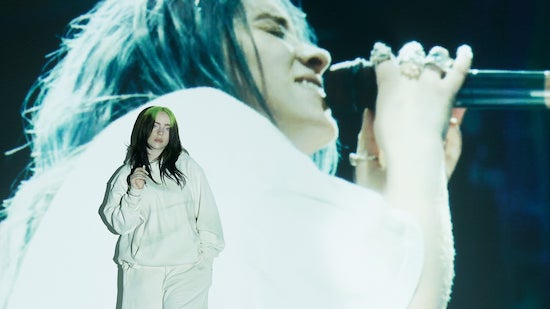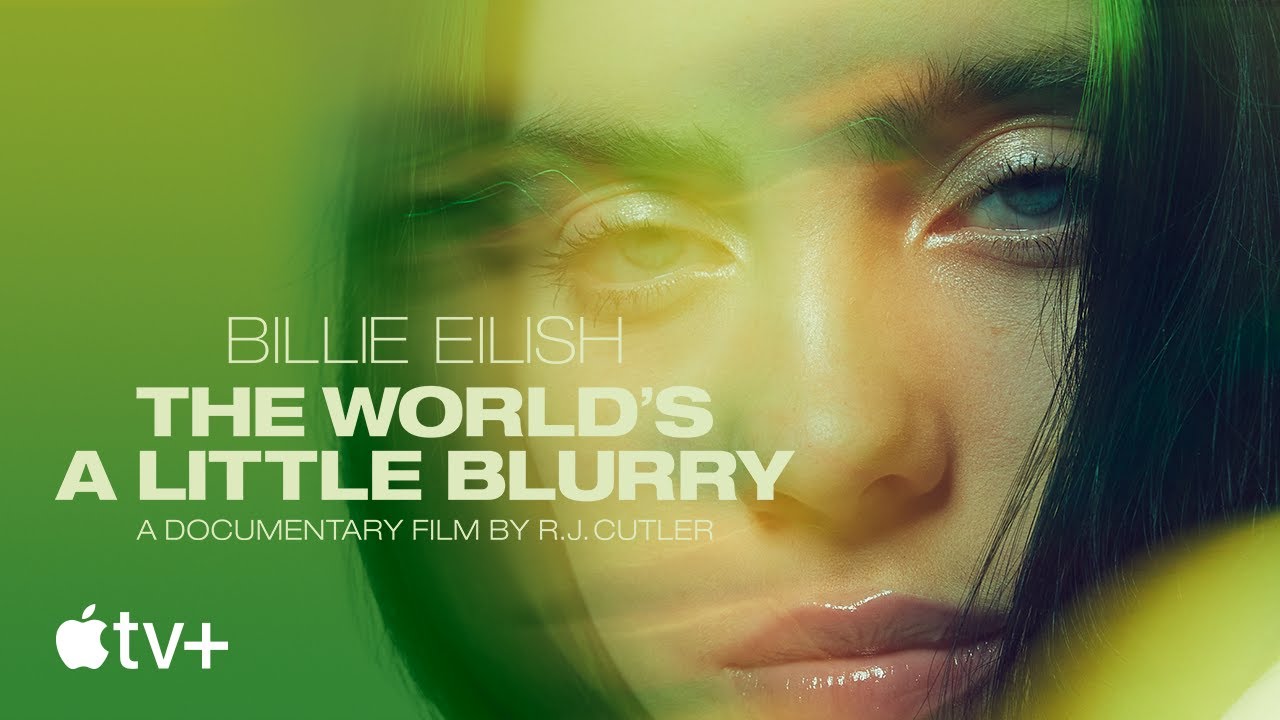“Rot”, “torture”, “void”, “hurt”, “broken” are just some of the words etched onto this teenage girl’s bedroom wall, and while they evoke either touch or the lack thereof, the close-ups of black handwriting give flesh to smudges and lines alike. It’s expected from a music documentary like Billie Eilish: The World’s a Little Blurry to establish the beguiling intimacy which arises from knowing the content of someone else’s nightmares, especially since Eilish has channelled her ephialtes in music and visuals. While the film closes with the 18-year-old singer-songwriter reflecting on the self-harming rituals she used to have as a teen, its opening scenes promise a rather anticipated form of closeness, typical for such artist-centered documentaries.
Billie Eilish: The World’s a Little Blurry opens with a slightly shaky take of the artist performing her debut single “Ocean Eyes” in the family garage. The informal setting mimics the unexpected circumstances which shot Eilish to fame – namely, that the song, first uploaded on SoundCloud in 2015, became financially successful after a re-release through Interscope Records the year after.
Before cutting to black, the garage scene unfolds through minimalistic means: the quivers of the camera, Eilish’s nervous chuckle while singing, and the backdrop of labeled storage boxes evoke a home video rather than a million-dollar film production. To no surprise, the documentary includes family archive material alongside behind-the-scenes footage from concerts, world tours, and Eilish’s life in between, to present an intimate portrait of a young star and the rapid rise of her fame. Shot between 2018 and 2019 and directed by documentary veteran R.J.Cutler (who admits he knew little to nothing about Eilish before he agreed to the project) the film captures the writing stages of Eilish’s avant-pop debut album “When We All Fall Asleep, Where Do We Go?” and ends with her winning five Grammy awards, including the four major categories. Even though the documentary has been marketed as a “true coming-of-age story”, the phrase reads like a placeholder, simplifying the individuating elements of a rise to world-wide popularity into a standard narrative arc. . Whether or not Billie Eilish: The World… partakes in the typically documentarian ‘truth-seeking’ ambition is quite unimportant, because this project give more to its audience, much more than the otherwise entertaining distinction between the on- and off-stage pop star. The idea of an absolute truth should is irrelevant here, especially since the director himself has insisted on having the definite say at the editing stage, (the so-called ‘final cut).,, cutting the initial 27 hours of assembly footage down to the 140 minutes it clocks at now.
The relatively new discipline of ‘star studies’ measures audience involvement in a progression from self-identification through imitation, to projection: the more one cares about the star in question, the more likely they are to see them as an object of (unattainable) desire. Similarly to how stardom presents a combination of an ‘ideal’, on the one hand, and ‘typical’, on the other, documentary practice juxtaposes belief (‘truth’, i.e. nonfiction) and imagination (‘falsehood’, i.e. fiction). Even vérité-style filmmaking relies on editing to string together fragments of ‘true’ life, and together with the readily-given emotional investment – or how the viewers are lured in witnessing the ‘life of the stars’ – such an amalgamation forms a mold for an engaging and often successful new genre within nonfiction films, which is the (pop) music star documentary.
Billie Eilish: The World… aims to bridge the gap between an on-stage (online) persona and an off-stage (offline) person, a goal shared by many documentaries of its type, and while the attention to the artist’s body is not a revelatory trope, Cutler’s film reinvents it in an innovative way. Some examples include White Diamond: A Personal Portrait of Kylie Minogue (2007) and Gaga: Five Foot Two (2017), and while these documentaries were released a decade apart, both refuse to turn a blind eye on their protagonists in pain. White Diamond follows Minogue on her first tour r after her breast cancer diagnosis and recovery (2006-2007), and Gaga accompanies Lady Gaga during the recording of her fifth studio album “Joanne” while suffering from fibromyalgia – a chronic medical condition which causes widespread body pain. Intertwining bodily vulnerability with cracks in a glossy surface image, such documentaries bring to the fore questions about not only the human body, but also the corporeality of stars.
On the one hand, the heightened attention to physical bodies signals a desire to reclaim one’s fame-produced narrative, as it’s been the case with the proliferation of scripted pop music documentaries, where pop stars insist on having the last word, or rectifying the media-storms which have affected their careers. Here, in the body-conscious documentary subgenre, the stars perform acts of self-affirmation not only through voiceover (disembodied), but through painful physicality. On the other hand, there’s a call to normalise representations of the ailing body and its fragility, since paying attention to weakened bodies, and especially to female bodies in pain, can act as a counter-narrative move to the fetishisation and standardisation typically associated with media-produced images of gendered beauty.
The World’s a Little Blurry is a labour-intensive documentary, with most sequences showing Billie Eilish either composing or recording, together with her brother and producer Finneas. When they’re not recording, Billie’s shown on tour, or conversing about her way of working, and these sequences are usually long takes, unfolding over minutes of screen time without a cut. An attentive, dynamic camera is the constant companion of Eilish, building her image as an uncompromisingly dedicated performer, her professionalism often coming at the expense of her own health. In such cases, the labour politics of stardom become tangible, since everything available to audiences, both in concert and in front of their screens, is an ever-permeating performance act which they champion and desire.
Countering that consumerist desire, directed towards a star figure, The World… also includes instances of the body taking over. While flicking through the promotional billboard plans for the upcoming album, Eilish falls quiet, her head tilting left to right to left again, and says: “Hold on, something’s happening here.” By her own words, she’s having a tic attack and this is how we learn that she has Tourette syndrome, a neurodevelopmental disorder that causes twitches and sudden movements, repeated again and again for the duration of the fit. Because the sequence is also shot in a long, calm take, it becomes a much-needed representation of a physical disability, a missing piece in an otherwise flawless star persona (by definition, stars are thought of as unimpaired, to serve an ‘ideal’, aspirational function). By making space for a depiction of an overly gesticular body, stuck in its repeated motions for as long as the tic attack lasts, the steady camera also channels some of Eilish’s creative, emotional energy. We become aware of our bodies only when they ache.
Dispersed through the documentary’s narrative are various agonisingly specific names of Eilish’s injuries. Shin splints, a crick in the neck, a sprained ankle, torn ligaments, a tear in the growth plate of her hip. Her singular hurts accumulate to the peak of a graphic description, that “the bone separated from the muscle.” Once a dedicated dancer, Billie had to dispense with her ballet choreography and flowing movements after suffering a hip impairment. Following the accident, her movement on stage became more chaotic and more vivacious and this alternative mode of physical engagement with concert audiences is evident in the film, in the many sequences of on-stage performances. In these moments, the documentary resembles a straightforward filmed concert, but the camera is ready to jump in sync with its subject, Billie’s moves seemingly grounded and gravity-resistant with her loose, oversized clothes and sturdy sneakers to meet the stage floor. In her performances, Billie Eilish makes use of a brusque, hypermobile choreography that maps out the steps which outline non-normative resistance against the typified feminine gestures and the expectations of a pop star’s behaviour on stage.
*
Milan, August 2019: Eilish sprained her ankle less than a minute in her performance of ‘bad guy’, which was the opener of her set. The happening exists online, possibly recorded by thousands of fans, and it’s no surprise that it made it to the final act of Billie Eilish: The World… Even if the documentary uses timelapses to tell the story of her accumulating leg injuries, it’s worth noting that, in order to finish her set in front of Milanese audiences, she had to overcome not just the physical pain but the fact that she saw her performance as flawed. “I can’t give you the show I wanna give you,” she confesses, tears in her eyes. At this point, the film swaps its truth-seeking behind-the-stage fascination for a surprisingly articulated comment on performance labour. Pop culture in general owes its glossy effortless look to the process of mastering the art of concealing its laborious practices. Therefore, the gap between person and persona is made more visible than ever here: one hurts, the other pretends not to.
After a short while, the artist appears on stage slightly limping, a cast now complementing her oversized t-shirt and wide-leg trousers. And yet she traverses the space, debilitated and determined, as if following the steps taken by her less-hurt legs on this and all other stages where she had performed. The documentary readily adopts its protagonist’s faltering pace: the pain of walking is enhanced by tracking close-ups of her hobbling, and inserts of ice bags, ice buckets, and leg braces. Physiotherapy and rehabilitative exercises take center stage, while the framing also singles out only ankles, feet, shins and calves – fragments of limbs, temporarily detached from the body.
*
Last month, Eilish appeared on the cover of Vogue to show what some have deemed a ‘makeover’, from non-conformist slacker image to a corset-bound blonde look, all the while keeping a disinterested facial expression as if to elude the male gaze. Released not long before, Billie Eilish: The World stands as the last document of the first chapter in the pop star’s public relationship to her own body. If the documentary shows an understanding of bodily ownership as disavowal of normative femininity, what comes next approximates a reclaim done on her own terms. In any case, Eilish’s beguiling persona has testified her resistance to the surface-level aestheticisation of the female body not only with her choice of clothes (concealing rather than revealing), style (neon green and black hair), but also the way she openly addresses her own relationship with self-harm. In the documentary’s closing scenes, Eilish confesses that, as a teenager, she felt complex guilt and unjustified satisfaction when dragging razor blades across her wrists and subsequently bandaging them up. Her vulnerability, by sharing with potentially millions of viewers a self-destructive practice, indicates another type of looking at skin as the body’s surface: creating scars as an acute mode of physical presence. Such a complex relationship with the body’s building blocks – be it limbs, blood, or skin – helps shift the focus from a gendered gaze, full of expectations, to an embrace of one’s hurting flesh and bones. “My body is always gonna be broken, even if I heal it. Even if you fix it, it’s still been broken,” she says in response to her mother’s plea to exercise and strengthen her legs. The metonymy here is crucial: legs equal body, and body equals existence.
Billie Eilish: The World… offers much more than an intimate portrait, or a compilation of the paratextual elements which compose the contemporary pop star. By paying attention to Eilish’s body, specifically its pains, instead of a stagnated paradigm of femininity, the documentary surpasses its like unobtrusively, by opening up physical space for pain. An artist as self-articulated as Billie Eilish can teach us a thing or two about agony – and maybe all lessons should begin with the terms of one’s own brokenness. And then… we jump, again, of course.



